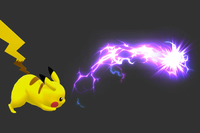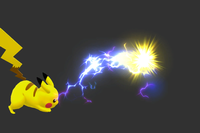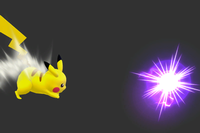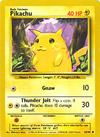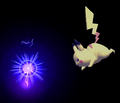Thunder Jolt
| Thunder Jolt | |
|---|---|
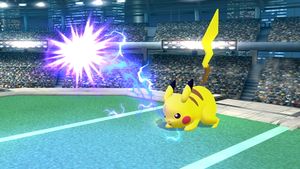 Thunder Jolt in Super Smash Bros. for Wii U. | |
| Users | Pikachu Pichu |
| Universe | Pokémon |
| Article on Bulbapedia | Thunder Jolt |
Thunder Jolt (でんげき, Electric Shock) is Pikachu and Pichu's neutral special move.
Overview
The user will shoot a small ball of electricity that will hit their opponent.
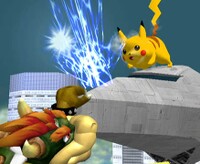
Upon use, the user drops a sphere of electricity diagonally downwards, which can deal medium damage as it falls. If it lands on a surface, it turns into an arcing wave of electricity that hops along the terrain's surface and deals slightly less damage. The projectile will wrap around corners and snake along walls and even ceilings if the corners are not too sharp and it lives long enough; it cannot wrap around the underside of soft platforms due to there being no ceiling to latch onto. When the move is used on the ground, it essentially turns into the wave form immediately.
Like its other specials and electrically charged attacks, Thunder Jolt damages Pichu upon use, inflicting 1% (0.4% in Ultimate) damage each time. Kirby also gets the damage if using the move after having copied Pichu.
Customization
Special Move customization was added in Super Smash Bros. 4. These are the variations:
| 1. Thunder Jolt | 2. Thunder Wave | 3. Thunder Shock |
|---|---|---|
| "Send a ball of electricity bouncing along the stage." | "The ball of electricity paralyzes foes but does less damage." | "Shoot a ball of electricity horizontally. Triggers a small blast as it disappears." |
- Thunder Jolt: Default.
- Thunder Wave: Inflicts roughly half as much damage and travels much less distance, but paralyzes targets.
- Thunder Shock: Is thrown horizontally and disappears upon hitting the ground without bouncing. Initially weaker than the regular variant, but unleashes a powerful blast at the end.
Origin
Unlike most other attacks Pokémon use in the Super Smash Bros. games, there has never been an attack named Thunder Jolt in any of the Pokémon RPGs. Thunder Jolt was, however, present on the original Pikachu card as one of the many moves invented for the Pokémon Trading Card Game (TCG); both the English and the Japanese names on the card match the Smash move's name in the respective versions of Smash Bros.. The name of the move in the Smash Bros. games likely arose from the popularity of the trading cards at the time of Smash 64. The move's effect in the TCG, where it damages Pikachu under certain circumstances, is similar to how Thunder Jolt works when used by Pichu; however, all of Pichu's electric type moves damage itself.
Its custom versions, however, are actual moves in the Pokémon games and match their effects accurately. Thunder Wave does no damage in the Pokémon RPGs, but it inflicts the Paralysis status. Thunder Shock is a basic low-level Electric-type attack that many Electric-type Pokémon start with. Both moves can be learned by Pikachu in all main series Pokémon games.
Gallery
Thunder Jolt performed in midair in Brawl.
Thunder Jolt following the platform it lands on in Brawl.
Prerelease shot of Thunder Jolt in Super Smash Bros. for Wii U.
Trivia
- The version of the move in Smash 64 has a hitbox that does not match with its appearance - it tightly hugs the ground as the visual effect bounces over it. Melee reworks the attack to have a hitbox in the expected place as well as one under the arch to hit crouchers. Brawl however deletes this coverage hitbox.
- In Smash 64, an interesting glitch can occur. When the user sends a grounded Thunder Jolt over a ledge (such as the one left of the Greenhouse on Hyrule Castle) while an opponent Fox's Reflector is active (and very near but not touching the wall), the Thunder Jolt's sprite will continue through the opponent with the animation direction reversed in a sort of electrical moonwalk, making the arc appear to bounce completely vertically rather than parabolically. This is purely visual and does not affect its hitbox, speed or duration.
- The voice clip played when Pikachu uses the move in Smash 64 is taken directly from a scene in episode 24 of the Pokémon anime series.
